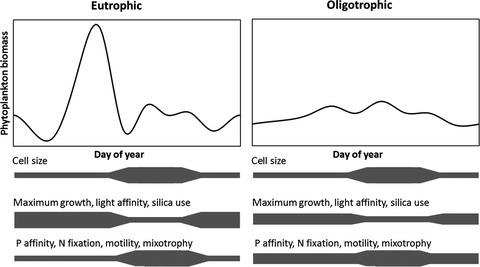Our official English website, www.x-mol.net, welcomes your
feedback! (Note: you will need to create a separate account there.)
Seasonal succession of functional traits in phytoplankton communities and their interaction with trophic state
Journal of Ecology ( IF 5.3 ) Pub Date : 2020-03-30 , DOI: 10.1111/1365-2745.13395 Valerie Carolin Wentzky 1, 2, 3 , Jörg Tittel 1 , Christoph Gerald Jäger 2, 4 , Jorn Bruggeman 5 , Karsten Rinke 1
中文翻译:

浮游植物群落功能性状的季节性演替及其与营养状态的相互作用
更新日期:2020-03-30
Journal of Ecology ( IF 5.3 ) Pub Date : 2020-03-30 , DOI: 10.1111/1365-2745.13395 Valerie Carolin Wentzky 1, 2, 3 , Jörg Tittel 1 , Christoph Gerald Jäger 2, 4 , Jorn Bruggeman 5 , Karsten Rinke 1
Affiliation

|
- Understanding and explaining the structure of communities in response to environmental gradients is a central goal in ecology. Trait‐based approaches are promising but yet rarely applied to understand community dynamics in response to changing environmental conditions.
- Here, we investigate seasonal succession patterns of functional traits in phytoplankton communities and how nutrient reductions (oligotrophication) alter these patterns. We used phytoplankton data from 40 years of observation from the Rappbode Reservoir (Germany), which underwent a strong shift in trophic conditions, and translated taxonomic composition into functional traits by assigning trait values compiled from the literature.
- All studied traits (morphological, behavioural and physiological traits) responded to changing environmental conditions and showed consistent, reoccurring seasonal developments. The seasonal succession of phytoplankton communities was shaped by a trade‐off between small‐celled, fast‐growing species that are able to rapidly incorporate existing resources (r ‐strategists) and large‐celled species with more complex and efficient mechanisms to exploit scarce mineral nutrients or acquire previously unexploited nutrient pools (k ‐strategists). In summer, when nutrients were scarce, the k ‐strategy was prevailing (important traits: phosphate affinity, nitrogen fixation, motility and mixotrophy). During the rest of the year, nutrients and turbulence were high and r ‐strategists dominated (important traits: maximum growth rate and light affinity).
- A comparison between eutrophic and oligotrophic years revealed that the main features of functional trait succession were largely preserved, but intra‐annual fluctuations from spring to summer were stronger during eutrophic years. Nutrient reductions mainly affected functional traits and biomass in spring, while in summer the functional community composition changed little.
- Synthesis . This study provides for the first time a quantitatively supported functional template for trait‐based succession patterns in lakes under different nutrient conditions. By translating taxonomic composition into trait information, we demonstrate that the quantification of functional characteristics enables ecological interpretation of observed community dynamics and provides not only a testable template but also a powerful tool towards a more mechanistic understanding. The quantification of functional traits further improves the predictability of community shifts in response to changing environmental conditions and thus opens new perspectives for predictive limnology using lake ecosystem models.
中文翻译:

浮游植物群落功能性状的季节性演替及其与营养状态的相互作用
- 了解和解释响应环境梯度的社区结构是生态学的中心目标。基于特质的方法很有前途,但很少用于理解社区动态以应对不断变化的环境条件。
- 在这里,我们调查浮游植物群落功能性状的季节性演替模式,以及养分减少(营养缺陷化)如何改变这些模式。我们使用了来自Rappbode水库(德国)40年观察的浮游植物数据,该营养条件发生了很大的变化,并通过分配根据文献汇编的特征值将分类学组成转换为功能特征。
- 所有研究的性状(形态,行为和生理性状)均响应不断变化的环境条件,并表现出一致的,反复发生的季节性变化。浮游植物群落的季节演替小室,速生树种,它们能够迅速整合现有资源(之间的权衡形[R -strategists)和大单细胞物种更复杂,更有效的机制来利用稀有的矿产养分或获取以前未开发的养分库(k策略师)。在夏季,当养分稀缺时,主要采用K策略(重要特征:磷酸盐亲和力,固氮,运动性和混合营养)。在这一年的剩余时间里,养分和湍流很高,r战略家占主导地位(重要特征:最大生长率和光亲和力)。
- 对富营养年和富营养年的比较表明,功能性状继承的主要特征在很大程度上得以保留,但是在富营养年中,春季至夏季的年内波动更大。营养物质的减少主要在春季影响功能性状和生物量,而在夏季,功能群落组成变化不大。
- 综合。这项研究首次为不同养分条件下湖泊中基于特征的演替模式提供了定量支持的功能模板。通过将生物分类组成转换为特征信息,我们证明了功能特征的量化能够对观察到的社区动态进行生态学解释,不仅提供了可测试的模板,而且还提供了一种更机械化的强大工具。功能性状的量化进一步提高了响应环境条件变化而引起的社区转移的可预测性,从而为使用湖泊生态系统模型进行预测性林学开辟了新的前景。











































 京公网安备 11010802027423号
京公网安备 11010802027423号